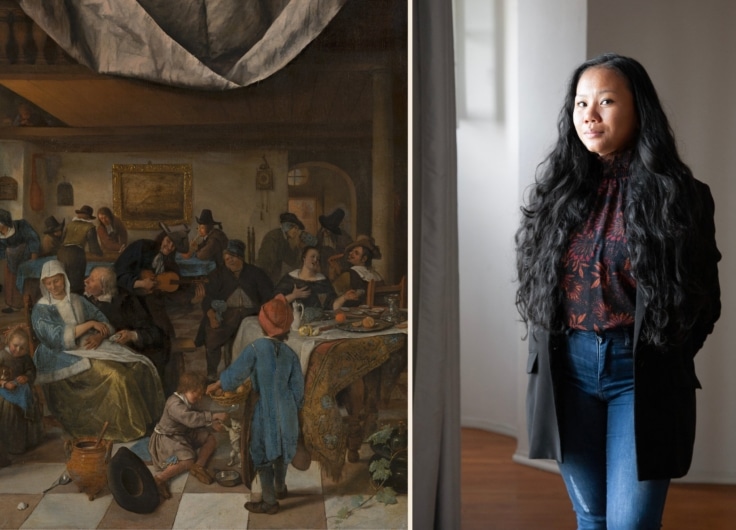Beautiful Language Can Hide in Great Sorrow
Nuances of Dutch language are sometimes difficult for non-native speakers, notes Fieke Van der Gucht, especially when it comes to bad news. But these difficulties have led to creative language discoveries; ‘I’m twenty per cent angry.’
My partner is a professional bad-news deliverer. Nobody wants to receive a visit from him at the door at night, because he never has any good news to bring: a daughter who won’t return from a party she has gone to, a father who took his own life. Because bad news does not take into account who you are, where you come from, and what your mother tongue is; those conversations, regardless of their content of course, can either be easy or difficult on a linguistic level.
Suddenly you realize how useful it is as a native speaker to be able to add nuance with words: ‘Your father sadly passed away yesterday. He took his own life by hanging himself.’ Only your mother tongue gives you the dexterity to bring difficult messages clearly, yet respectfully. No matter how well speaking with gestures helps to explain everyday situations (for example, for ‘you may not do that’ a waving index finger is extremely effective), gesticulating answers to the question of how father took his own life, is extremely painful.
Only your mother tongue gives you the dexterity to bring difficult messages clearly, yet respectfully
Moreover, descriptions such as ‘stepping out of life,’ or ‘robbing oneself of life’ are too concealed for next of kin who have limited proficiency in Dutch, you often end up using clumsy direct language such as ‘Your father is dead. How? Using a rope tied to the stairs,’ while you may or may not illustrate this with a noose around the neck. Although I understand that in practice it often has to be done, it makes my stomach cringe: the seriousness of the message contrasts too much with the simplistic style with which the message is conveyed.
Also, for non-native bad-news receivers, it is helpful to capture big emotions with that message in small words: happy, scared, angry, or sad
sound too cold, too shallow. But even in great sorrow, beautiful language can hide. To overcome the lack of nuance, many Dutch people come up with fantastic alternative responses such as: ‘Of course I feel sad because my father died, but I also feel relieved. He was struggling, he had been drinking too much for years. And honestly? I’m pretty angry as well, because he never wanted to accept our help.’ My partner noted that a striking number of non-native speakers resort to percentages: ‘I’m seventy percent sad, but also twenty percent happy and ten percent angry.’ In anticipation of the moment when you are taught the adjective relieved, I think twenty percent happy is a touching and beautiful find in language.
If you solely use a command as a Dutch learner, you come across as rude and authoritarian
Unfortunately, not all messages can be expressed in percentages. Dutch scholars who want to get certain things done, often resort to the imperative or commanding form of Dutch verbs. This is no big surprise, because it seems like a piece of cake. If you know the verb root, usually the infinitive without “en”, then you know the imperative. For example: the infinitive is zwijg-en (to be silent) and the command: “zwijg!” (shut up), together with the verb root zwijg. It’s as simple as that.
But there is a catch. If you solely use a command as a Dutch learner, you come across as rude and authoritarian. To make a command usable, you have to add eens, maar, toch (sometime, but, yet), or a combination of those soothing words. And those words always create subtle differences in meaning, all of which a foreigner has to master. While “kom hier!” (come here) is an order, “kom maar hier!” (come here please) sounds like a friendly request, “kom toch hier!” (get down here) as an impatient summon, and “kom toch eens hier” (get down here now) as an even more agitated demand. In addition, “doe dat maar” (please go ahead) sounds a lot more casual than “doe dat!” (do that), although much, of course, depends on the way you pronounce the sentences. Go and try it for yourself!
Native speakers perfectly understand that knives lay in the cutlery drawer, and that glasses stand on the table
Not to mention the terrible verbs to sit, to stand, and to lay. Native speakers perfectly understand that knives, spoons, and forks lay in the cutlery drawer, and that glasses stand on the table (with the exception of that one glass that got knocked over – that one lays). For non-native speakers, that looks like pure randomness. You could say that object that are taller-than-wide stand and objects that are wider-than-tall lay, yet plates and frying pants also stand on the table. And those are considerable wider-than-tall. Furthermore, a book can lay on your bedside table and stand in the bookcase. When the bookcase has closed doors, you can even say that your books sit in the cabinet.
While I got lost in linguistic articles that exposed the complicated semantics behind to sit, to stand, and to lay, I completely forgot that my partner was waiting for me in front of the movie theatre. ‘Sorry. Are you angry?’ I asked when I arrived too late. ‘Twenty per cent,’ he said.












